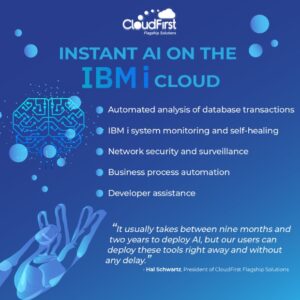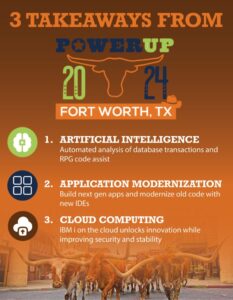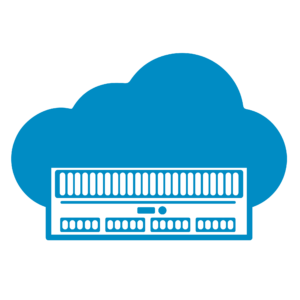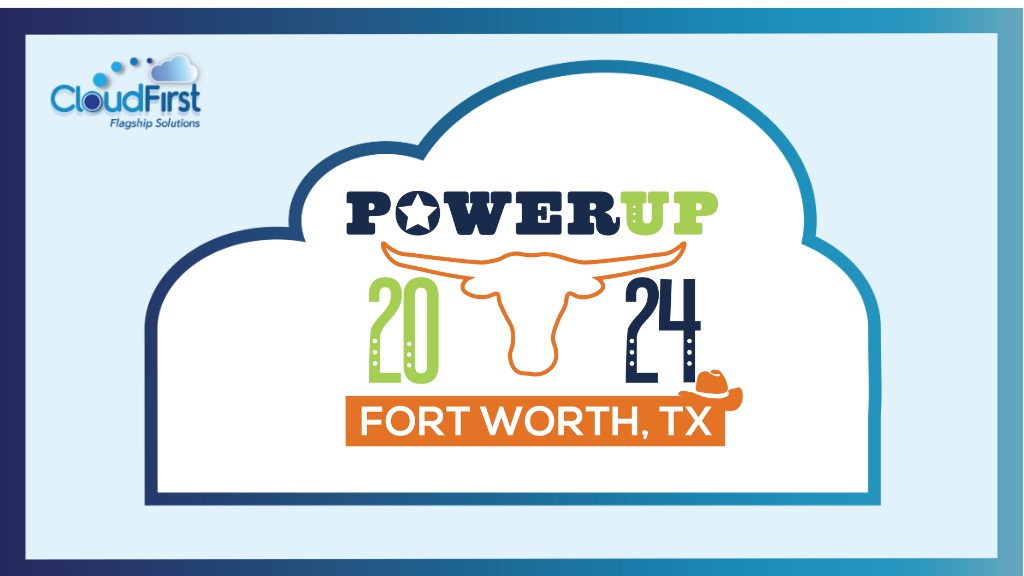We’re always looking for insights into the latest trends in Power Systems technology and how real end users are taking advantage of IBM i. So we went straight to the source.
COMMON POWERUp 2024 is the annual gathering of IBM i experts, administrators, developers, and service providers. CloudFirst hit the floor to talk to leading voices so we can share these exciting developments with you.
IBM Power Systems are known for their reliability, resilience, and security, and they’re far from outdated. Today’s enterprises are leveraging IBM i to take advantage of the latest innovations in AI, application modernization, and hybrid cloud infrastructure.
Here’s how.
AI for IBM i

Artificial intelligence is the talk of the town, and for good reason. It’s not some hypothetical, far-off thing that will take you years (and millions of dollars) to develop and deploy. It’s actually easier than you think to get started using AI for IBM Power Systems.
Database transaction triggers
One practical use case is for realtime learning and analysis of database transactions. We all know that IBM i has the world’s best relational database management system (RDMS). AI makes that even more powerful.
“We can embed AI into a Db2 transaction,” explains Jesse Gorzinski, Business Architect at IBM. “For instance, before a database insert trigger, we can run some analysis like sentiment analysis or language translation.”
Customer experience is a great example. Let’s say a customer fills in a form on your website’s support page. Inserting that information into a database can trigger an AI model which can then determine whether the customer is frustrated, confused, angry, etc. It could also translate their request into other languages. All of that new data then goes into the database to add valuable context, enabling your team to provide better customer service.
The good news? You don’t have to wait.
“We’ve got AI and automation tools within our cloud that our customers can take advantage of right now,” says Hal Schwartz, President of CloudFirst. “It usually takes between nine months and two years to deploy AI, but our users can deploy these tools right away and without any delay.”
RPG code assist
RPG is a programming language that’s specifically optimized for the IBM i operating system, and programs written in RPG have formed the IT backbone of many corporations for decades. The problem is that (a) most programmers don’t have much experience working with it, and (b) a lot of RPG code in production today was written many years ago in previous versions that are much more rigid.
Both senior and junior developers can benefit from an AI assistant to help them write new code, create tests, and summarize and understand old code. However, unlike more prevalent open source languages like Python and JavaScript, there’s not that much of it out there on the open internet, meaning AI models like ChatGPT and Microsoft’s Copilot don’t have enough good data to train a reliable model.
That’s why Steve Will, IBM i CTO and Chief Architect, has started an effort to bring code assist to RPG. “We’re launching a project to train a ready-for-primetime AI,” he announced in the opening keynote session. “We’re using all the RPG code that IBM has ever developed, and we’re also using more code that was donated by experts and champions.”
He’s soliciting the larger IBM i community, asking anyone who is willing to contribute their code to submit it to help train this new model. We think this is a great way for the community to come together to create something that will benefit everyone.
However, there are some caveats. “I would encourage people to contribute,” says Chuck Paolillo, CloudFirst’s CTO, “as long as they can be cautious about security risks, not exposing intellectual property, and not revealing sensitive internal information.”
Practical business outcomes of AI on IBM i
Making developers more efficient and getting more out of your databases is great. But as a business leader, you’re concerned with tangible outcomes.
For instance, leading manufacturers are combining AI and IBM Power to enable industrial automation. They’re running machine learning on the edge, such as a computer vision system, to boost efficiency on the assembly line.
This data then feeds back into a database on IBM i, either on-prem or on the cloud, where it can then be subject to further analysis. This can reveal problems or opportunities for improving the manufacturing process.
Another thing we’re seeing a lot of is system monitoring and self-healing. “It’s like self-driving cars,” says Gorzinski. “How about self-driving IBM systems? It can summarize what’s going on, figure out what’s going wrong if an app keeps crashing, and do self-healing.”
The end result is high availability, better security, and lower costs associated with administration.
At CloudFirst, we do the same thing with system and network analysis. We run AI on our network 24-7 so we can immediately detect any intruders and stop them in their tracks before they get the chance to do any damage. This is just one way we’re using AI to deliver more value to our customers.
Application modernization on IBM i

Whether it’s building a new app from the ground up or making a new version of a tried-and-true program, today’s IBM Power Systems users are creating tons of exciting new next-generation apps for their businesses.
In many ways, this starts with new choices in integrated development environment (IDE), which is a programming interface that adds a lot more functionality beyond the classic “green screen.” One of the most advanced options is IBM Rational Developer for i, or RDi, which contains a suite of tools for editing, debugging, and refactoring code. This inherently encourages modernization.
A central part of the IBM i philosophy, however, is that providing developers with the ability to “choose their own adventure” will also encourage modernization. This is why the team at IBM also recently released the IBM i Modernization Engine for Lifecycle Integration, or Merlin.
This toolset includes an IDE, continuous integration/continuous delivery (CI/CD), and several other tools. It runs on a Red Hat OpenShift container platform. This makes it ideal for developers who are building cloud-native applications with IBM i and Kubernetes.
As if two weren’t enough, there’s also a third option: Code for IBM i on Visual Studio. Especially for developers who already know and love Visual Studio, this is a great option for an IDE that will help them modernize applications on IBM Power Systems.
In addition to new ways to develop code, there are also new ways to tie applications together.
When companies modernize their old code bases, they can then begin integrating their applications and databases with new open source software and other technologies. For instance, going back to the AI hype train, we see organizations creating systems that simultaneously pull data from multiple sources—say, Db2 on a CloudFirst deployment and Amazon RDS on AWS—and then use that for either AI training or inference.
IBM i on the cloud

Whether you want to get started with AI, implement application modernization, or even just prioritize high availability and secure backups, everything we’ve mentioned so far begins and ends with cloud infrastructure.
Cloud computing for IBM Power Systems was a major recurring theme at COMMON POWERUp 2024.
“Enterprises that are more intentional with hybrid cloud will accelerate impact,” says Steve Sibley, VP of IBM Power Product Management. He points to a study called the IBM Transformation Index: State of Cloud, which shows that “71% of execs think it’s difficult to realize the full potential of digital transformation without having a solid hybrid cloud strategy in place.”
Hybrid is a key word here. IBM i is part of the overall tapestry of many companies’ IT. It needs to work seamlessly with the rest of their IT, whether that’s serverless architecture on AWS, Windows Server on Microsoft Azure, or anything in between.
By offering Direct Connect, a secure, high-speed pipeline between our Power Systems cloud and all other major cloud providers, CloudFirst offers the multi-cloud solution that companies need to modernize their IBM i infrastructure and start getting value from AI.
“All of this starts in the cloud,” concludes Schwartz.
The cloud isn’t only good for next-gen applications. It’s good for everyone because it reinforces the key tenets of what makes IBM i an attractive system: reliability, resilience, and security. It compounds all of those powers together, and then it adds on automation and modernization.
“CloudFirst offers a 100% uptime service-level agreement, and we’re accountable to our customers to maintain that level of service,” says Paolillo. “Our cloud also provides scalability, lets you grow as needed, and reduces capital expenditure and overall costs.”
Concluding COMMON POWERUp 2024
AI, application modernization, and cloud computing may be the biggest trends coming out of this year’s COMMON conference, but they’re certainly not the only ones. The IBM i community continues to innovate and grow by staying true to what makes our platform great while also looking for ways to expand and add value.
If you’re ready to take the next step and move your IBM Power Systems to the cloud so you can take advantage of the latest and greatest technologies, get in touch with CloudFirst today.

